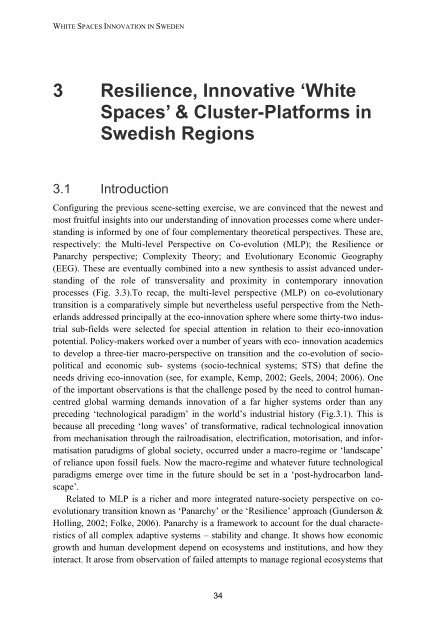White Spaces Innovation in Sweden - Innovation policy for ... - Vinnova
White Spaces Innovation in Sweden - Innovation policy for ... - Vinnova
White Spaces Innovation in Sweden - Innovation policy for ... - Vinnova
Create successful ePaper yourself
Turn your PDF publications into a flip-book with our unique Google optimized e-Paper software.
WHITE SPACES INNOVATION IN SWEDEN3 Resilience, Innovative ‘<strong>White</strong><strong>Spaces</strong>’ & Cluster-Plat<strong>for</strong>ms <strong>in</strong>Swedish Regions3.1 IntroductionConfigur<strong>in</strong>g the previous scene-sett<strong>in</strong>g exercise, we are conv<strong>in</strong>ced that the newest andmost fruitful <strong>in</strong>sights <strong>in</strong>to our understand<strong>in</strong>g of <strong>in</strong>novation processes come where understand<strong>in</strong>gis <strong>in</strong><strong>for</strong>med by one of four complementary theoretical perspectives. These are,respectively: the Multi-level Perspective on Co-evolution (MLP); the Resilience orPanarchy perspective; Complexity Theory; and Evolutionary Economic Geography(EEG). These are eventually comb<strong>in</strong>ed <strong>in</strong>to a new synthesis to assist advanced understand<strong>in</strong>gof the role of transversality and proximity <strong>in</strong> contemporary <strong>in</strong>novationprocesses (Fig. 3.3).To recap, the multi-level perspective (MLP) on co-evolutionarytransition is a comparatively simple but nevertheless useful perspective from the Netherlandsaddressed pr<strong>in</strong>cipally at the eco-<strong>in</strong>novation sphere where some thirty-two <strong>in</strong>dustrialsub-fields were selected <strong>for</strong> special attention <strong>in</strong> relation to their eco-<strong>in</strong>novationpotential. Policy-makers worked over a number of years with eco- <strong>in</strong>novation academicsto develop a three-tier macro-perspective on transition and the co-evolution of sociopoliticaland economic sub- systems (socio-technical systems; STS) that def<strong>in</strong>e theneeds driv<strong>in</strong>g eco-<strong>in</strong>novation (see, <strong>for</strong> example, Kemp, 2002; Geels, 2004; 2006). Oneof the important observations is that the challenge posed by the need to control humancentredglobal warm<strong>in</strong>g demands <strong>in</strong>novation of a far higher systems order than anypreced<strong>in</strong>g „technological paradigm‟ <strong>in</strong> the world‟s <strong>in</strong>dustrial history (Fig.3.1). This isbecause all preced<strong>in</strong>g „long waves‟ of trans<strong>for</strong>mative, radical technological <strong>in</strong>novationfrom mechanisation through the railroadisation, electrification, motorisation, and <strong>in</strong><strong>for</strong>matisationparadigms of global society, occurred under a macro-regime or „landscape‟of reliance upon fossil fuels. Now the macro-regime and whatever future technologicalparadigms emerge over time <strong>in</strong> the future should be set <strong>in</strong> a „post-hydrocarbon landscape‟.Related to MLP is a richer and more <strong>in</strong>tegrated nature-society perspective on coevolutionarytransition known as „Panarchy‟ or the „Resilience‟ approach (Gunderson &Holl<strong>in</strong>g, 2002; Folke, 2006). Panarchy is a framework to account <strong>for</strong> the dual characteristicsof all complex adaptive systems – stability and change. It shows how economicgrowth and human development depend on ecosystems and <strong>in</strong>stitutions, and how they<strong>in</strong>teract. It arose from observation of failed attempts to manage regional ecosystems that34
















